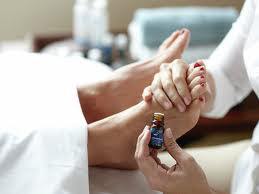 Essential oils are highly concentrated and should be used with great care. Stronger oils like clove, cinnamon and basil are hot oils and should always be diluted before using. Thinner skin like on the face and neck may require the dilution of oils more likely than the palm of the hand or bottoms of the feet. Individuals with asthma should have oils applied to the bottoms of the feet rather than inhaling oils as this may irritate the respiratory tract. If a rash occurs, this most often is toxins being eliminated from the body – if Young Living Oils are used. Using any other brand of oils does not guarantee safety in usage as the oils may contain unknown synthetics or fillers that could irritate the skin.
Essential oils are highly concentrated and should be used with great care. Stronger oils like clove, cinnamon and basil are hot oils and should always be diluted before using. Thinner skin like on the face and neck may require the dilution of oils more likely than the palm of the hand or bottoms of the feet. Individuals with asthma should have oils applied to the bottoms of the feet rather than inhaling oils as this may irritate the respiratory tract. If a rash occurs, this most often is toxins being eliminated from the body – if Young Living Oils are used. Using any other brand of oils does not guarantee safety in usage as the oils may contain unknown synthetics or fillers that could irritate the skin.
Essential Oils can be applied topically: Essential oils applied directly from the bottle are called ‘neat’. Oils applied with a carrier oil, such as Young Living’s V-6 oil will extend the oil a bit more and is helpful for using the essential oils in massage. Essential oils can be inhaled, simply from the bottle or the palm of the hand, diffused from a Young Living Diffuser, applied topically to the skin or taken internally as a food additive – any oils safe for ingestion will have the white food supplement label on the bottle. Consult your User’s Guide and Essential Oils Desk Reference for specific information on each oil’s usage.
Common areas to apply oils are directly where they are needed: a drop of peppermint essential oil applied to the temples can help for a headache, PanAway applied directly to a sore joint for pain relief, or lavender essential oil can be applied directly to a burn (make sure to use only Young Living therapeutic grade lavender for a burn, any inferior oil applied to a burn could make the injury worse). Reflexology is the practice of applying essential oils to the soles of the feet which are the source of nerve endings corresponding to many points of the body. The large toe for example, corresponds to the head and applying lemon oil to the big toe may alleviate a migraine headache.
Essential Oils can be Inhaled. Simply breathing essential oils may be useful for managing stress. The aroma of an appealing scent can help alleviate anxiety. Synthetic oils should never be used for this as the chemicals may actually make anxiety worse. Inhaling an oil is sometimes used for situations like respiratory conjestion, using a Young Living blend like R.C or a eucalyptus to soothe the respiratory tract.
Diffusing essential oils is perfect for deodorizing the air. You could diffuse a blend like Purification to neutralize odors. Thieves blend or Frankincense would be helpful in disinfecting the air when someone is battling a cold or flu. We’ve prevented the spread of many illnesses in our home by diffusing essential oils when someone comes down with a bug. It is also helpful to use the anti-bacterial blends like Thieves to clean frequently used surfaces like door knobs, light switches and faucets.
Food Grade Essential Oils can be ingested. Many of Young Living’s single essential oils are certified by the FDA as food grade, so they are safe for internal use. Just follow the recommended dose on each bottle. Some oils like Thieves, clove or lemon can be placed in a spoonful of rice milk or agave nectar and simply swallowed. Oils can also be filled into a supplemental gel cap available at most health food stores. Internal use is effective for targeting digestive issues like nausea & diarrhea (Peppermint oil), and systemic inflammation. Internal usage is also excellent as a dietary supplement as with Longevity essential oil.
Essential oils are powerful substances and should be combined with common sense. If you have a condition requiring medical treatment, see your doctor. The information on this website is for educational purposes only and Pure Home and Body LLC does not intend to diagnose, treat or cure any disease.














No comments yet.